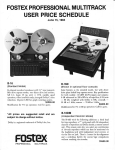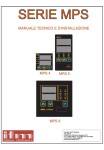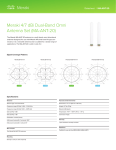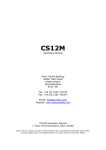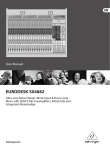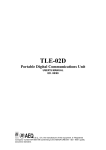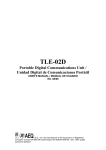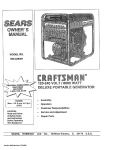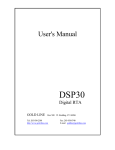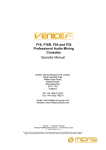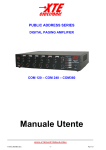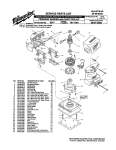Download scepter user guide
Transcript
- - - - SCEPTER 12 channel - Rack Mount Mixer -. OWNER MANUAL - Allen & Heath Publication: APO093 Issue 3 OWNER MANUAL October 92 ALLEN & HEATH - - This product continues ALLEN & HEATH’s commitment to provide high quality tools engineered to meet the exacting requirements of today’s audio business. It brings you the latest in high performance technology and offers the reassurance of over two decades of audio console manufacture and customer support. _ _-- Whilst we believe the information in this manual to be correct and reliable we do not assume responsibility for any errors or omissions. We also reserve the right to make changes in the interest of further product development. -- We are able to offer you further product support through our network of approved dealers and service agents. To help us provide the most efficient service please would you return your completed WARRANTY REGISTRATION card, and enter the following details below to be quoted in any communication CONSOLE model: I1 serial number: I1 -- POWER UNIT model: - serial number: - - - - - -- - - ALLEN & HEATH BRENELL LTD. LIMITED ONE YEAR WARRANTY This product has been manufactured in the UK by ALLEN & HEATH BRENELL LTD and is warranted to be free from defects in materials or workmanship for a period of one year from the date of purchase by the original owner. To ensure proper validation and handling of warranty services please return the WARRANTY REGISTRATION CARD,. To ensure the high level of performance and reliability for which this equipment has been designed and manufactured, please read the Owner Manual before use. In the event of a failure notify and return the defective unit to ALLEN & HEATH or its authorised agent as soon as possible for repair under warranty subject to the following conditions: CONDITIONS OF WARRANTY: 1. The equipment has been installed and operated in accordance with the instructions in the Owner Manual, - 2. The equipment has not been subject to misuse either intended or accidental, neglect, or alteration other than as described in the Owner/Service Manual, or approved by ALLEN & HEATH. - 3. Any necessary adjustment, alteration, or repair has been made by ALLEN 8z HEATH or its authorised agent, 4. The defective unit is to be returned carriage prepaid to ALLEN & HEATH or its authorised agent and proof of purchase made available on request, 5. Units to be returned should be packed to avoid transit damage and be accompanied by the Power Supply Unit. These terms of warranty apply to UK sales. In other territories the terms may vary according to legal requirements. ALLEN & HEATH AGENT: FACTORY: ALLEN & HEATH BRENELL LTD Kernick Industrial Estate Penryn Cornwall TRlO 9LU A Harman international Company Allen & Heath PAGE CONTENTS 1 ...... INTRODUCTION General Information. ......................... ................ 1 Safety & Precaution .......................................... 2 installation ........................................................ 3-4 User Service Information ................................... 5 Electronic Performance ..................................... 6-7 2 ...... PANEL CONTROL DIAGRAMS Input Channels ................................................. 8-9 L/R Section .............. ......................................... 10-11 Master Section ........ ......................... ................ 12-13 Rear Panel .............. ......................... ................ 14-16 3 ...... USE OF FACILITIES FRONT PANEL CONTROLS Input Channel Section ....................... ................ 17-20 Left/Right Section ............................................. 21 Master Section ........ ......................... ................22-23 4. . . . . . REAR PANEL CONNECTORS Input Channel Section ....................... ................24 L/R Section .............. ........................................ ,25-26 Master Section ................................................. 27-28 D.C. Power connector ....................... ................29 5 ...... USER CONFIGURED OPTIONS Access to Mixer Circuits .................... ................30-31 Options Descriptions ......................... ................32 Direct Outputs .................................................. 32 Chan Aux Sends .*.a* ......................................... 33-34 Stereo Rtn Aux Sends ....................... ................34 Mono & Stereo Output ...................................... 35 User Options Table ......................................... .36 Chassis Ground Isolation .................. ................37 ......................................................... ................ continued Allen & Heath CONTENTS continued - PAGE 6 . . . . . . SERVICE INFORMATION DIAGRAMS Main IDC Ribbon Connector . . . . . . . . . ...* ..*...,......... Dimensions Diagram . . . . . . . . . ..*......*...... ..*.....*.*..*.. System Block Diagram .,..*.*..*.....*..,... . . . . . . . ...*..... 7...... SCHEMATIC DIAGRAMS -_ ... - Input Components and Option Placement.. ....... Input Circuit Diagram ........................ ................ Left / Right Components and Option Placement Left / Right Circuit Diagram ............... ................ Master Components and Option Placement.. .... Master Circuit Diagram...................... ................ EBOS Components & Circuit Diagram.. ............. Power Supply Components & Circuit Diagram . . Section 1 Audio Owner Manual INTRODUCTION - The Allen & Heath SCEPTER RACK MOUNT MIXER is a versatile, economical and easy-to-use general purpose rack mount mixer intended for stereo and mono PA applications as well as stereo recording. The quality of design, construction and components employed will ensure high performance in these applications when correctly used. Operators and installers are encouraged to study the contents of this handbook. - Construction: - 1. 2. 3. 4. 5. 6. 7. Aluminum front panel, stove enamel, enamel silk-screened legend. Steel Rear Panel and Chassis, grey stove enamel finish. Individual Channel assemblies secured to Front and Rear panels. Internal busbar circuits employ removable IDC harness. Glass-epoxy circuits cards for strength and reliablity All audio path ICs are socketed for ease of service. IC op-amp and discrete component circuit design. AC Power Requirements: Allen & Heath power supplies MPS8-R (Supplied), MPS8-P, MPS9, and RPS-1 provide the necessary DC power for the mixer. These are the only power supplies recommended for use with this product. Use of power supplies other than those specified may void the mixer warranty. All Allen & Heath power supplies operate on the following mains voltages/frequencies 220-240V AC 50/60 Hz 50VA Europe 11 O-1 20V AC 50/60 Hz USA 100 Volt AC 50/60 Hz 50VA Japan NOTE: The MPS-8R power supply is provided as standard with the Scepter. providing +15 Volts and -15 Volts for mixer operation, and +48 Volts for Phantom Power microphone operation. It is configured as a Rack Mount Power Supply for standard 19” racks. If necessary the Front Panel may be removed to enable remote mounting. Further details on mains voltages are available within the SERVICE section of this manual. 1 Section 1 Audio Owner Manual Mains electricity is dangerous and can kill. Mains voltage is present within the power unit but not the Scepter unit. Check your mains wiring and earthing before connecting up and switching on. The purpose of the “earth” (ground) connection in a mains supply is for the prevention of electric shock from the mains voltage present. It is usual for the chassis of mains powered equipment to be connected to earth to prevent the metal parts becoming “live” and causing electric shock. Some are “double insulated” and do not require an earth connection. The Scepter power supply (MPS-8R) must be connected to a suitable mains earth through the designated earth wire in the mains cord. The power supply mains earth is not connected to the Scepter earth. The unit should be connected via a different path to mains earth. (see CHASSIS GROUND LIFT section) Equipment will continue to function if it is not connected to mains earth. This does not mean that it is safe. GOVERNMENT AND INSURANCE UNDERWRITERS ELECTRICAL CODES MUST BE OBSERVED. These codes take precedence over any suggestions in this manual. 2 Section 1 Audio Owner Manual - INSTALLATION - .- - Unpack the unit from the packing carton. Remove the power supply unit from the packing. We recommend that you keep intact this purpose designed packing to reuse should you need to ship the unit in the future. Please ensure that the Scepter unit, power supply and other items are correctly repacked to avoid transit damage. Please ensure that the fader knobs are in the up position. Check that the AC operating voltage marked on the power unit is the same as the local supply. Connect the DC power cord from the power supply into the rear panel of the Scepter unit. Ensure that it latches firmly. -Earthing/Grounding in the audio system ._ There two important reasons why it is necessary to ensure that your audio system is well earthed (grounded). 1) 2) - .- Safety - prevention of electric shock (see previous section on SAFETY) Shielding - preventing external electrical interference from causing noise in the audio signal path. In addition to solving noise and interference problems, earthing can also cause them. If there are multiple earth paths in a system then an “earth loop” can be formed. This usually results in an excess hum in the system, but can also cause the breakthrough of RF and other noises. The preferred method to overcome earth loop problems is to earth all pieces of equipment separately to a good “star point” mains earth and to break potential earth loops by disconnecting the screens of the audio cables at one end, usually the signal destination. If excessive RF interference is present this may be reduced by connecting the screen to earth through a small value capacitor, typically 0.01 microfarad Alternatively; just one piece of equipment, usually the power amplifier, is connected to mains earth and the other equipment earthed via the interconnecting cable screens which must be connected at both ends. However, having only one unit connected to mains earth means that all of the other pieces of equipment rely on the audio cable screen for safety. It is important to remember this. Test regularly, that all exposed metal equipment including microphones, guitar strings and DI boxes have a low resistance to mains earth. 3 Section 1 Audio Owner Manual The console is not connected to mains earth for the reasons mentioned above and under normal operating conditions it contains no dangerous voltages. The power supply chassis is connected to mains earth and must never be disconnected. Likewise never disconnect the earth wire in the mains plug. It is best to plan ahead and have your installation checked by a competent engineer before you commence. Do not trust equipment and installations modified by others. 4 Section 1 Audio Owner Manual - - USER SERVICE INFORMATION .- There are no adjustments or alignment procedures required to maintain the performance standards of this Allen & Heath product. To preserve the working life of the unit and its presentation, avoid the use of chemicals, abrasives and solvents. The control panel is best cleaned with a soft brush and a damp cloth. Switches and potentiometers are lubricated for life; the application of electrical lubricants to these parts is not recommended. - A number of user options are available. These are changes to the functions of various controls and outputs which can be altered by the user repositioning internal jumper links. The details of these options are covered under in USER CONFIGURED OPTIONS section of this manual. Any modifications to the unit other than those specifically listed will automatically void the warranty. - . Section 1 Audio Owner Manual ELECTRONIC PERFORMANCE OdBu - 0.776 Volts RMS 1 kHz OVU = +4dBu = 1.23 Volts RMS Unreferenced dB represents Voltage Gain MAX VOLTAGE GAIN: Figures include 10dB input and group fader boost MIC IN to L/R Out,.., ,,,.........I*.........*. +80dB LINE IN to L/R Out . . . . . . . . ..*..........*....* +62dB L/R to Mono Out..,.,. .....**......*.......s.*. +1 OdB FX RETURN to L/R Out . . . . . . . . . . . . . . . . . . . . +24dB INPUT PAD ..a.....,.... ,,,...................... -16dB INPUT GAIN CONTROL RANGE......52dB .*.............**...*.....***... . . . ..*...*..............* 70dB with Pad FREQUENCY RESPONSE: Equalizer set to flat response or switched out . . . . . . . . . . . . . . 20Hz to 20kHz +0/-l dB. INTERNAL OPERATING LEVEL=. . . ..*......**............* Channel= OdBu; L/R= -2dBu ALL OUTPUTS AND INSERTS IN-PHASE REF TO XLR PIN 2 INPUT AND l/4” TIP CONNECTOR. OUTPUTS: LEFT - RIGHT - MONO Self Compensating Electronically Balanced Capable of Balanced or Unbalanced operation Max level +27dBu Bal, +2ldBu Unbal Recommended load 600 ohms or greater Connectors - 3 pin XLR Type Pin 1 = Gnd (with lift switch) Pin 2 = + Pin 3 = When pin 2 or 3 grounded, Opposite output pin gain is increased by 6dB ALL OTHER MONO OUTPUTS Unbalanced; Max level +21 dBu Recommended load 600 or more: 2k or more for Channel Insert & Direct Out Connector - l/4” Phone Jack Tip is +, Ring and Sleeve= ground DISTORTION: 6 - +a Section 1 Audio Owner Manual - - -- ELECTRONIC PERFORMANCE continued THD typically better than 0.04% 20Hz-20kHz at ‘normal levels and gain settings RMS noise 20kHz bandwidth NOISE PERFORMANCE: L or R Output(all input faders closed)-83dBu L or R Output(1 input @ unity gain)-83dBu Aux Outputs(Unity gain)-90dBu Microphone Input equivalent noise-l 27dBu (200 Source) - 7 Section 2 Audio Owner Manual FRONT PANEL CONTROLS. INPUT CHANNEL 1. LINE L-J GAIN Adjusts the gain of the input pre-amplifier to suit input levels. Control range is +18 to +66dB (mic) and -4 to +43dB (line). PAD 2. - LINE Selects between Microphone and Line input sources. With the switch engaged, Line input is selected. 3. PAD When selected, reduces the input signal level by approximately 16dB. 4. AUX SENDS A,B,C,D Allows the operator to create up to four different mixes to be used as foldback, effects or cue mixes as desired. The SCEPTER mixer is delivered from the factory with AUX SENDS A and B set for PRE-FADER operation. AUX SENDS C and D are set for POST-FADER operation. Internal jumpers are provided to allow custom configuration of all Aux buses.(SEE USER OPTIONS) 5. HIGH FREQUENCY EQUALIZER Boosts or cuts the High Frequencies by up to 16dB at the corner frequency of 1OkHz with Shelving characteristics. AUX SENDS HF - 0 + 6. MID FREQUENCY SWEEP CONTROL Selects the center frequency affected by the mid frequency gain control. Continuously variable from 250Hz to 6 kHz. 7. MID FREQUENCY EQUALIZER Boost or cuts the Mid Frequency by up to 12dB. Approximately 1 octave around the center frequency with Peak/Dip characteristics MID - ? + 6. LOW FREQUENCY EQUALIZER Boost or cuts the Low Frequencies by up to 16dB at the corner frequency selected by the Low Frequency Select Switch. E 9. LOW FREQUENCY SELECT SWITCH Selects the corner frequency of the Low Frequency Equalizer between 12OHz(Up) and GOHz(Down). 10. III EQ IN EQ IN With this switch engaged, the EQ section is active in the channel. With the switch released the EQ section is bypassed. 8 - Section 2 Audio Owner Manual - FRONT PANEL CONTROLS - INPUT CHANNEL (cant) - - 11. HIGH PASS FILTER SWITCH Causes a gradual roll off in level of all frequencies below 80Hz at a rate of -12dB per octave. Useful in eliminating unwanted low frequency sounds. - 12. - Positions input signal anywhere between the Left and Right outputs of the stereo mix. Full counter-clockwise routes all of the input signal to the left channel. Full clockwise routes all of the input signal to the right channel. With this control centered, an equal amount of signal is routed to the Left and Right channels. PFL B PEAK &IG 0 PAN CONTROL * 13. MUTE SWITCH (with LED Indicator) Cancels or mutes the channel and all of its auxiliary sends (SEE USER OPTIONS), but does not affect PFL or peak and signal present indicators. The mute LED illuminates when the channel is MUTED. 14. PFL SWITCH Allows the operator to monitor channel levels prior to the fader, regardless of fader level or channel mute status. Used with the input gain control (1) and peak indicator (15) and signal present indicator (16) to accurately set input signal levels. With PFL selected, the peak indicator(l5) will come on at half intensity. 15. PEAK INDICATOR LED (Red) Illuminates 3dB before the onset of actual channel clipping and is affected by the INPUT GAIN, EQ Settings, and CHANNEL FADER settings. If any circuit is approaching overload, the LED indicator will illuminate. 16. SIGNAL PRESENT INDICAT.OR (Green) Illuminates when input signal is above -3OdB. Green LED indicator will vary in intensity with normal signal input variations. 17. 1 CHANNEL FADER Controls the level of the input channel to the Left/Right and Mono outputs and any POST fader auxiliary sends. The fader marking 0 is normal operating position, indicating unity gain between input and output sections. There is an extra 1OdB boost available at the fader which is obtained by raising the fader to its full up position. 9 Audio Owner Manual Section 2 FRONT PANEL CONTROLS MONITOR L LEFT/RIGHT SECTION (Left is Shown) +6 References in ( ) are for Right Master +3 -0 1. -3 L(R) MONITOR METERS These multipurpose meters monitor any source selected by the Monitor section of the Master Module. When no switch is selected within the monitor section, Left and Right outputs are displayed. When any PFL switch on the mixer is engaged, these meters automatically display the signal that is present at that position. Ref level is +4dBv; range is from -2ldB to +6dB with VU type response. -6 -9 -12 -15 -18 -21 L R L-J PFL EFX RETURNS 2. EFX RETURN 1 (2), 3 (4) These four returns allow mono line level signals (i.e. the output from effects devices) to be added to the stereo mix. The l/4” TRS Input jack can accept either -10 levels on the Tip or +4 levels on the Ring. Each ER( RETURN includes a LEVEL control, BALANCE POT, and PFL. L I R PFL 10 Section 2 Audio Owner Manual - FRONT PANEL CONTROLS - L/R CHANNEL (Cont) - LEFT/RIGHT SECTION Left is Shown References in ( ) are for Right Master - 3. The two STEREO RETURN inputs allow STEREO input signals (i.e. the output of stereo tape machines or stereo effects devices) to be mixed with the main outputs. The l/4” TRS(stereo) jack accepts -10 levels; Left on Tip, Right on Ring. Each STEREO RETURN includes a LEVEL control, AUX SENDS A & B, a MONO switch which mixes Left and Right input signals together, a BALANCE control, MUTE and PFL switch. - - E l STEREO RETURN 1 & (2) MONO - L R MUTE STEREO RTN 1 PFL 4. L(R) PEAK INDICATOR LED’ Illuminates 3dB before the onset of L/R clipping. Monitors both the summing amp and fader amp for overload. - 5. MASTER LEFT (RIGHT) OUTPUT FADERS Controls the master level of the MAIN STEREO XLR outputs. Normal position is at 0; 10 dB boost’is available if needed. - 11 Section 2 Audio Owner Manual FRONT PANEL CONTROLS - MASTER SECTION 12v LAMP 1. 12V LAMP BNC Connector to accept most of the popular goose neck lamps to illuminate the mixer work area. B 1-j +48 2. D PWRON Master power switch for 48 Volt PHANTOM POWER (for use with CONDENSER microphones). A 3. B +46 PHANTOM POWER LED Indicates that the Master Phantom Power switch is turned on and phantom power is present in the mixer. 4 5 6 4. POWER ON LED Indicates that power is on to the mixer. In the event that this LED is not illuminated, check that the external power supply is plugged into the mixer and the power supply is plugged into an operational wall outlet. 5. AUX MASTERS A, 8, C, D The master output level controls for auxiliary mixes A, B, C, and D. AUX MASTERS STEREO OUT 6. STEREO OUT Master level control for an l/4” stereo output. Signal for this output is derived from the stereo mix prior to the Master LeftI Right slide faders (see USER OPTIONS) A.MUTE switch is provided. MUTE 7. MONO OUT Master level control of the MONO output. Signal for this output is a mono sum of the stereo mix prior to the Master LefVRight slide faders (see USER CONFIGURED OPTIONS). A MUTE switch is provided. MONO OUT 12 - Audio Owner Manual Section 2 FRONT PANEL CONTROLS - MASTER SECTION (cant) AUX A 0 - a. AUX B AUX C AUX D - 1-1 MONO I - MONITOR SELECT and LEVEL This section selects the signal to the HEADPHONE OUTPUT on the front panel and the MONITOR OUTPUT on the rear panel. It also routes the selected signal to the LED Meter section of the mixer. If no switches are engaged (and no PFL LED illuminated), this signal is the LEFT/RIGHT output of the console. When a switch within the monitor section is selected, it automatically routes to the Headphone Output, Monitor Output, and Meters. In the event that multiple switches are selected, the switch closest to the BOTTOM of the panel has priority. When ANY PFL switch is selected, the PFL ON LED indicator is illuminated, and this signal has priority over any other switch position. When illuminated, the PFL signal is present in the Headphones, Monitor output, and visually on the LEFT/RIGHT meters. J MONITOR SELECT - @ PFL O N SCEPTER RACK 9. HEADPHONE JACK Accepts stereo headphones of 75. ohms or greater. Output determined by the Monitor Select section. Headphone level is controlled by the front panel control labeled LEV (Monitor Level). - HEADPHONES 13 Section 2 Audio Owner Manual MASTER 0 PIN 1 LIFT 0, MASTER CONNECTIONS PIN 1 LIFT Used to disconnect pin 1 from the MONO output connector. Used to eliminate ground loops. MONO BAL OUT Male XLR-3 (Pin 2 Hot). Self Compensating Electronically Balanced. Controlled by Mono Out Level pot. Normally derived from mix of Pre-Fader Left & Right(See Options Section). Nom level of +4dBv; Capable of +27dBv output into 600 ohms or greater. AUX OUT A 0 AUX OUT B 0 AUX OUT C AUXAUNBALANCEDOUT l/4” Jack. Controlled by Aux A Master. Nom level of +4dBv; capable of +2ldBv into 600 ohms or greater. AUXBUNBALANCEDOUT l/4” Jack Controlled by Aux A Master. Nom level of +4dBv; capable of +2ldBv into 600 ohms or greater. AUXCUNBALANCEDOUT l/4” Jack. Controlled by Aux A Master. Nom level of +4dBv; capable of +2ldBv into 600 ohms or greater. AUXDUNBALANCEDOUT Q3 AUX OUT D l/4” Jack. Controlled by Aux A Master. Nom level of +4dBv; capable of +2ldBv into 600 ohms or greater. STEREOUNBALANCEDOUT 0 EREO 0 MONITOR OUT l/4” Stereo Jack; Tip is Left, Ring is Right. Controlled by Stereo Out Level pot. Normally derived from Pre-Fader Left & Right(See Options Section). Capable of +2ldBv into 600 ohms or greater. MONITOR UNBALANCED OUT l/4” Stereo Jack; Tip is Left, Ring is Right. Controlled by Monitor Level pot. Signal follows Monitor Select switch and Auto-PFL. Capable of +2ldBv into 600 ohms or greater. 0 14 Section 2 Audio Owner Manual - LEFT & (RIGHT) CONNECTIONS LEFT PIN 1 LIFT - Used to disconnect pin 1 from the LEFT(RIGHT) output connector. Use to eliminate ground loops. - LEFT(RIGHT) BAL OUT Male XLR3 (Pin 2 Hot). Seff Compensating Electronically Balanced. Capable of +27dBv output into 600 ohms or greater. _ EFX RETURN 1 (2) INPUT l/4” Stereo Jack Tip accepts -10 devices, Ring accepts +4 devices EFX RTN EFX RETURN 3 (4) INPUT l/4” Stereo Jack. Tip accepts -10 devices, Ring accepts +4 devices EFX RTN 3 STEREO RETURN 1 (2) l/4” Stereo jack; Tip is Left, Ring is Right. Normally accepts -10 level Stereo effects devices or Tape Decks. STR RTN 1 Q Q l/4” Stereo Jack used to insert signal processing devices into the Main outputs. The TIP connection is the SEND, and the RING connection is the RETURN. L INSERT L BUS IN _- LEFT (RIGHT) INSERT JACK LEFT(RIGHT) BUS IN l/4” Jack for inputing signals directly into the Main mix amps. Used for stacking two mixers together. -2dBv input level. 15 Section 2 Audio Owner Manual INPUT INPUT CHANNELS INDIVIDUAL PHANTOM POWER SWITCH When engaged, turns on the +48v phantom power for that channel if the Master +43v switch on Front Panel is on. MIC INPUT CONNECTOR 3-pin Female XLR connector used to connect balanced low (mic) level signals into the channel. LINE INPUT JACK Balanced l/4” stereo jack used to connect high (line) level signals into the channel. Will accept balanced or unbalanced signals. CHANNEL INSERT JACK INSERT l/4” Stereo Jack used to insert signal processing devices into the channel. The TIP connection is the SEND, and the RING connection is the RETURN. CHANNEL DIRECT OUT l/4” Jack for Individual Channel out signals. Normally set as Post-Fader/Post-Mute. DIRECT OUT 16 - Section 3 Audio Owner Manual - - - - - USING THE SCEPTER SERIES MIXER THE INPUT CHANNEL The input channel accepts a balanced or unbalanced input signal from a microphone, direct box or a line level source such as the output of a synthesizer, or external signal processing device such as a digital delay line, reverb, etc. Phantom Power 1 The SCEPTER Series Mixers are factory wired for the +48 volt DC. phantom powering of condenser microphones. When the master phantom power switch is on and the individual channel phantom switch is on, +48 volts is present at XLR pins 2 and 3. Power supplies MPS8-R, MPS8-P, MPS9 and RPSl provide the necessary voltage. The master phantom power pushbutton switch is located at the top of the master section on the front panel. The individual channel phantom power on switches are located on the rear panel above the MIC connectors and can be activated with a pencil or similar object. NOTE: When using phantom power it is important to avoid connecting an UNBALANCED signal source to the MICROPHONE input without having first switched off the phantom power to that channel. Input Gain Control The input gain control is used to vary the gain of the ‘input preamp. Control range is +2dB to +66dB for MIC and -2OdB to +44dB for LINE. These figures include the effect of the PAD switch. Line Switch When depressed, this switch selects the Balanced Line Input (l/4” stereo jack). as the source for the Channel. The Balanced Mic input (3 pin XLR) is selected when the switch is in the UP position. Input Pad Switch On occasion, situations may arise where high level signal sources (a live kick drum, or some drum machines and synths) overload the input channel, even though the input gain control is set at minimum. Engaging the PAD switch reduces the incoming mic or line signal by 16dB. Should the amount of attenuation prove to be excessive, the input gain control can be raised to bring the signal level up to the desired level. The PFL system can be very useful here, and should be employed to set channel gain to the proper level. - 17 Section 3 Audio Owner Manual Channel Auxlliary Sends Each Scepter input channel features four auxiliary send controls. These controls feed auxiliary masters A, B, C and D and allow the user to create four additional mixes of the signal sources fed to the mixer. These mixes are generally used as feeds to external FX devices, as foldback mixes to an onstage monitor system, or as a cue mix for performers headphones in recording situations. Aux A and B are normally PRE-EQ feeds to the Aux A and B mixes. These mixes are unaffected by channel EQ settings and fader position and may be used as feeds to an on-stage monitoring system. It should be noted that whilst these mixes are not affected by changes in the EQ settings, they ARE affected by changes made at the input gain control, and changes made there may require that a proportional change be made at the aux send. Aux C and D are normally POST-FADER feeds to the Aux C and D mixes. Their operation is dependent on the level of the channel fader and will change proportionally with fader movements and will be cut off when the mute switch is activated. For this reason, these mixes are normally used to feed external FX devices. SCEPTER Series mixers have been wired in this configuration at manufacture. However provision has been made within the mixer which allow the user to choose the point in the channel circuit from which the aux level control derives its source. For further information, see USER CONFIGURED OPTIONS section. Equalizer The channel EQ allows you to alter the tone and harmonic balance of the signal in the channel. You can filter out unwanted high frequency noise (hiss), or low frequency noise (rumble), and compensate for deficiencies in older microphones or problems with your acoustic environment. High Frequency Equalizer This control either boosts or cuts the high frequency content of the signal source by up to 16dB at 1OkHz and above, having progressively less effect at frequencies below 1OkHz. This is known as a shelving type equalizer. At its centre position the control has a flat response and no effect on the high frequency content. Mid Frequency Select This control tunes the mid centre frequency between 250Hz and 6kHz. 18 Section 3 Audio Owner Manual Mid Frequency Equalizer This control provides 12dB of boost or cut at the frequency selected by the Mid Select control. This is a peak/dip type equalizer. It affects sounds both above and below the selected frequency within a range of approximately one octave (Q-l .4). This means that boosting the mid equalizer at 2k affects not only 2k but also the frequencies surrounding it, but to a lesser degree. This control has no effect on the signal when set to the centre flat position. - Low Frequency Equalizer This control boosts or cuts the low frequency content of the signal source, by up to 16dB, below 60 Hz or 120 Hz depending on the position of the low frequency select switch. It has a shelving characteristic and at its centre position the control has no effect on the low frequency content. Low Frequency Select Switch This switch is used to select the frequencies affected by the Low Frequency Equalizer. In the up position, a corner frequency of 120Hz is selected; when engaged, 60Hz is selected. Eq In Switch This switch is used to activate the EQ section in the channel signal path. When the switch is in the up position, the channel signal bypasses the EQ section. Hi Pass Filter Switch Depressing this switch engages an 80Hz, -12dB/octave filter. This filter is independent of the 3-band channel EQ and is useful for eliminating stage rumble, wind noise and other low frequency sounds. Pan Control The input signal can be placed anywhere in the stereo image by turning the PAN to the right or the left. When the pan control is turned fully left, the input signal is routed to the left stereo output only. Turned fully right, the signal is routed to the right stereo output. When the PAN is in the centre position, the signal is equal in level to both the left and the right. Mute Switch - When depressed, this switch mutes or cancels the signal from the channel after the channel fader. It also mutes signals going to any Aux mixes. An option allows the Pre-EQ Aux source to be unaffected by the MUTE switch (See USER CONFIGURED OPTIONS section.) 19 Section 3 Audio Owner Manual PFL Button (Pm-Fader Llsten) Engaging the PFL allows you to listen to the Pre-Fader signal in the monitor and headphone outputs. The PFL system takes its signal after the EQ section but before the channel fader. This allows you to make signal level and quality checks before bringing up the channel in the mix. When a PFL switch is engaged, the L/R meters will indicate the PFL level; the channel PEAK Indicator will illuminate at half intensity; and the PFL indicator in the master section will illuminate. Peak signal Indicator This red LED illuminates when channel audio signals approach overload. The peak detection circuit samples the signal after the preamp, after the equaliser and after the fader so revealing risk of overload at all stages. Signal present Indicator This green LED monitors the signal at the output of the channel preamp. The intensity will vary with the strength of the channel signal starting at -3OdBu and reaching a constant intensity when the signal reaches approx OdBu. The EQ, fader and mute settings will not affect the LED. Channel Fader Used to alter the level of an individual channel in the mix. Normal operating position is at the 0 mark. However, an extra 1OdB boost can be obtained with the fader fully up. Also provides the signal feed to AUX mixes selected for POST FADER operation. 20 Section 3 Audio Owner Manual LEFT/RIGHT SECTION L/R Monitor Meters Each meter is a IO segment LED display which provide a visual indication of the source selected by the monitor select switches. Calibrated in 3dB steps from -21dB to +6dB, each meter is a VU type(average) responding meter with the 0 position indicating an output level of +4dBu (1.23~ RMS). -- - - EFX Returns 1,2,3,4 By use of the control marked LEVel these inputs can be used to bring signals from external effects devices back into the stereo mix. A PAN control is used to place the signals within the stereo image as desired. A PFL switch allows you to monitor the EFX return signal prior to its level control. The EFX RTN jack is configured to provide either unity return gain or +12dB return gain. For low level (-1OdBV) devices, the return plug should be inserted all the way into the jack socket: this provides 12dB extra gain. For high level (+4dBu) devices, insert the plug halfway into the EFX RTN jack to provide unity gain. Alternatively, use a stereo jack plug and connect the input signal to the ring contact. Use the EFX PFL switch to help determine the proper position if not certain. Stereo Return l/2 Two independent low level (-1OdBV) stereo inputs are provided for return tape or stereo effects into the L/R mix. Sends A & B are available for mixing the signal to the Aux buses for wet monitoring. These sends are normally set up as pre-level mono. Internal jumper links can be altered to reconfigure the sends as post-level stereo (left to Aux A, right to Aux B) if desired.(See USER CONFIGURED OPTIONS sections). The BALance control positions the Stereo Return signal in the L/R mix with up to 6dB cut. The MONO switch mixes the Left(tip) and Right(ring) inputs together and changes the BALance control to a normal PAN control. The MUTE switch cuts the signal to L/R and to any Aux sends set for Post-level. The PFL switch allows the operator to monitor the Return independently of the LEVel control. L/R Peak Indicator LED Warns of imminent overload distortion (3dB below clipping) when the signal level in L/R approaches this threshold. The circuit monitors both the tJR mix amp and line amp; even if the fader is down, you will still be notified of mix amp overload. L/R Output Faders Controls the level of the stereo mix to the L/R Balanced outputs. - 21 Section 3 Audio Owner Manual MASTER SECTION 12V Lamp This BNC Connector will accept 12 volt D.C. goose neck lamps rated at 50mA to 150mA current consumption. Used to illuminate the mixer work area. +48 Master power switch for +48 Volt PHANTOM POWER (for use with CONDENSER microphones). When this switch is depressed, the LED will illuminate indicating that power is supplied to any channel whose individual Phantom switch is on. Power on LED Indicates that power is being supplied to the mixer. In the event that this LED is not illuminated, check that the external power supply is plugged into the mixer and the power supply is plugged into an operational wall outlet. Aux Masters A, B, C, D The master output level controls for auxiliary mixes A, B, C, and D. For optimum performance (i.e. lowest noise), these controls should be set at 7 and the individual channel sends should be set as high as possible. Stereo Out Master level control for the stereo output l/4” jack socket. Signal for this output is derived from the Pre-Insert stereo mix prior to the Left/Right faders. A switch is provided to Mute this output when desired. Use this control when an independent output is needed for a video or tape feed. Post-Insert and Post-Fader selections are also possible.(see USER CONFIGURED OPTIONS section) Mono Out Master level control of the MONO output. Signal for this output is a mono sum of the Pre-Insert stereo mix prior to the Left/Right faders. A MUTE switch is also provided for this output. Post-Insert and Post-Fader selections are also possible.(see USER CONFIGURED OPTIONS section) 22 Section 3 Audio Owner Manual I- h h.. Monitor Select and Level This section selects the signal for the HEADPHONE OUTPUT on the front panel and the MONITOR OUTPUT on the rear panel. It also routes the selected signal to the LED Meters. If no switches are selected (and no PFL LED illuminated), this signal is the LEFT/RIGHT output of the console. When a monitor select switch is depressed, it routes the selected signal to the Meters, Headphones and Monitor Output. The LEVel control sets the volume to the two outputs, but has no effect on the meter. In the event that multiple switches are selected, the switch closest to the BOTTOM of the panel has priority. When any PFL switch is selected, the PFL ON LED will illuminate and the PFLed signal will override the selected monitor signal; multiple PFL switches mix together. When all PFL switches are released, normal monitoring resumes. w.- Headphone Jack Accepts stereo headphones of 75 ohms or greater. Output source and level as described above. - - - - - - 23 Section 4 Audio Owner Manual REAR PANEL CONNECTORS INPUT CHANNEL CONNECTIONS Individual Phantom Power Switch When selected, this switches the +48v D.C. phantom power for that channel but only if the Master +48 switch is also selected on the front panel. Use this switch only for condenser mics that need powering. Avoid using phantom power on dynamic or ribbon mics. A dynamic mic will usually be unaffected, but damage can occur to some ribbons. Mlc Input Connector 3 pin XLR connector used to connect balanced low (e.g. mic) level signals into the channel. Pin 2 is hot, Pin 3 is low and Pin 1 is shield. Input impedance is approx 3k Ohm without pad, dropping to 2k Ohm with pad. Line Input Jack Balanced l/4” stereo jack used to connect high (e.g. line) level signals into the channel. This will accept balanced or unbalanced signals. Tip is hot, Ring is low and Sleeve is shield. For unbalanced signals, use Tip for the input and tie Ring and Sleeve to the shield (this happens automatically when you use a mono l/4” jack plug). Input impedance is 20k Ohm balanced, 1 Ok Ohm unbalanced. Channel Insert Jack l/4” Stereo Jack used to insert signal processing devices into the channel. The Tip is used for the SEND, and the Ring connection is used for the RETURN. The insert point is located after the preamp (either Mic or Line input) and before the EQ section. Nominal signal level is OdBu, output impedance is 50 Ohm, return impedance is >50k Ohm. This jack can also be used as a borrow jack ; insert a stereo plug with Tip and Ring tied together to access the preamp output without affecting the channel signal. Useful if you need a Pre-everything feed and all the Auxes are tied up Channel Direct Out This unbalanced output is normally the Post-fader, Post-mute channel signal. Internal jumper links allow you to change this point to Pre-fader or Post-fader, Premute (See USER CONFIGURED OPTIONS Section). Output impedance is 50 Ohm. The recommended load is 2k Ohm or greater; Nominal level is OdBu. Use this jack if an isolated signal is needed. By using the Post-fade/Pre-mute position and muting the channel to the Scepter L/R mix, each direct out can be treated as a 1 input mixer; the controls will function as indicated, but the signal will only be present at the Direct Out jack. 24 Section 4 Audio Owner Manual LEFT & RIGHT CHANNEL CONNECTIONS Pin 1 Lift This recessed switch is used to disconnect Pin 1 from ground on the LEFT/ RIGHT output XLR connectors. Used to eliminate ground loops when connecting up different pieces of equipment Use a pencil or other thin probe to activate the switch; Pin 1 is lifted when the switch is IN. ,- L - - -- Left/Right Main Outputs Main outputs for the Left and Right mix amps. These XLR connector outputs follow the L/R faders. Their outputs can be monitored on the L/R LED meters. 3-Pin balanced XLR. Pin 2 hot, Pin 3 low, Pin 1 ground. Output impedance ~75 Ohm, nominal level +4dBu, maximum level of +27dBu balanced, +2ldBu unbalanced. These outputs are self-compensating electronically balanced. They can be operated unbalanced with either polarity, by taking the signal from the desired pin (2=lnphase; 3=inverting), and connecting the unused output pin to ground. The output of the driving pin will increase by 6dB to compensate for the loss of the grounded pin. EFXRtn 1,2,3,4 l/4” stereo jack for returning effects back into the Scepter L/R mix. By using the appropriate jack connection, high or low level EFX devices can be accommodated. The Tip of the jack is for low level (-1 OdBV) EFX devices; +12dB gain is provided with this connection to bring the output level of the device up to +BdBu. For high level (+4dBu) EFX devices, use the unity gain Ring connection either by inserting the plug half way in or by wiring the plug using the Ring connection instead of the Tip. Input impedance is 25k Ohm for low level, >lOOk Ohm for high level. Stereo Return 1,2 l/4” stereo jack for returning stereo EFX, Tape, CD or other low level stereo sources into the Scepter. The jack is wired for low level (-1OdBV) inputs; Tip being Left input and the Ring as right. Input impedance is 50k Ohm in stereo mode, dropping to 20k Ohm when the MONO switch is pressed(Tip & Ring inputs are mixed thru 1 Ok Ohm resistors with MONO). Aux A & B pre-level sends are available for wet monitoring. L/R Insert l/4” Stereo Jack used to insert signal processing devices into Left or Right. The Tip is used for the Send, and the Ring connection is used for the Return. The insert point is located after the mix amp just before the fader. Nominal signal level is -2dBu, output impedance is 50 Ohm with a recommended load of 600 Ohm or 25 Section 4 Audio Owner Manual greater. The return impedance is 10k Ohm. L/R Bus In This l/4” unbalanced jack is used to inject signals into the Left & Right mix amps. Use this jack when stacking 2 mixers together. This allows the Slave mixer outputs to get to the Master mixer without tying up input channels or returns. The nominal level is -2dBu with an input impedance of 33k Ohm. 26 Section 4 Audio Owner Manual - MASTER SECTION CONNECTIONS Pin 1 Lift - This recessed switch is used to disconnect Pin 1 from ground on the MONO output XLR connector. Used to eliminate ground loops when connecting up different pieces of equipment Use a pencil or other thin probe to activate the switch; Pin 1 is lifted when the switch is IN. Mono Output Main Mono output. Normal source is a mix of L&R Pre-insert signals. User may select; either Post-insert L&R or Post-fader L&R. (See USER CONFIGURED OPTIONS section). Output level is controlled by MONO OUT control and MUTE button on front panel. 3-Pin balanced XLR. Pin 2 hot, Pin 3 low, Pin 1 ground. Output impedance ~75 Ohm, nominal level +4dBu, maximum level of +27dBu balanced, +21 dBu unbalanced. These outputs are self-compensating electronically balanced. They can be operated unbalanced with either polarity, by taking the signal from the desired pin (2=In-phase; 3=inverting) and tying the unused output pin to ground. The output of the driving pin will increase by 6dB to compensate for the loss of the grounded pin. - Aux Out A, B, C, D - l/4” jacks, unbalanced outputs of the Auxiliary buses. Aux A & B are normally - set up as Pre-EQ and are typically used to generate a stage monitor mix. Aux C & D are normally Post-fader and are used for EFX sends. The individual mixes are set up using the Aux sends on each channel and the overall level is determined by the Aux Master controls. The output of each Aux can be monitored by depressing the appropriate switch in the Monitor Select section. Nominal level of +4dBu, output impedance of ~50 Ohm, recommended load of 600 Ohm or greater. - Stereo Out - This l/4” stereo jack is normally the Pre-insert output of the Left & Right mix amps. Tip is Left, Ring is Right. The Level and Muting are controlled by the front panel controls associated with the STEREO OUT section. Additionally, the user can change this output to follow either the Post-insert or Post-fader signals of the L & R mix amps(See USER CONFIGURED OPTIONS section). Output level is variable, max output is +2ldBU into 600 Ohm or greater. Monitor Out This l/4” stereo jack follows the Monitor Select switches and Auto-PFL. The output level is controlled by the Monitor Level control on the front panel. Use this -- 27 Section 4 Audio Owner Manual jack to feed a mix to a Control room amp in a studio situation, or a performer mix for a keyboard player. Output level is variable, max output is +2ldBu into 600 Ohm or greater. Tip is Left, Ring is right. The Headphone jack on the front panel follows the same signal as this output but is designed to drive a pair of headphones (75 Ohm or greater). 28 Section 4 Audio Owner Manual DC POWER CONNECTOR - - 5Pin male XLR for connection to Allen & Heath power supply unit. MPS-8R is normally supplied with the Scepter, but an MPS-8P, MPS-9, or RPS-1 with the proper cable can also be used. Your warranty will be void if a power supply not supplied or approved by Allen & Heath is used. The Scepter is designed to allow. the user to lift the chassis from the audio ground. This is useful in rack mounting situations since the rack rails may be at a different potential than the audio ground. This can cause ground loops. By allowing the chassis to be lifted from the audio ground, the ground loops can usually be eliminated. See the USER CONFIGURED OPTIONS section for this procedure. DC connector pinout (For Reference only) Pin1 . **..,.......*..*....*.........*.. -15 volts @ 500mA Pin 2 ................................. 0 volts (Audio ground) Pin 3 ................................. 0 volts (Audio ground) Pin 4 ................................. +I 5 volts @ 500mA Pin 5 ................................. +48 volts @ 1 OOmA Shell ................................. Chassis Chassis connection tied to Pin 3 (Audio gnd, Ovolts) with 22 Ohm link. - 29 Section 5 Audio Owner Manual SERVICE ACCESS ACCESS TO MIXER CIRCUITS To implement any User Options, you will need to gain access to the internal circuit cards, The various jumper links later defined are located on those cards. Follow the outlined procedure to safely open the Scepter mixer. The Scepter is composed of individual glass-epoxy circuit cards secured to a silk-screened aluminum front panel. A steel rear panel is secured to the rear of the circuit cards by numerous jack nuts. This sub-assembly (i.e. Front panel, Circuit cards and Rear Panel) is then inserted into a steel chassis. Eight 6x32 front panel counter-sunk screws and eight 6x32 rear panel screws hold both assemblies together. The front carrying handles also hold the two assemblies together with four 10x32 screws. In order to get to the jumper links, you will have to first remove the Front panel/Circuit card/Rear panel sub-assembly from the chassis and then remove the Rear panel from the Circuit cards. The jumper links will then be accessible. NOTE: If you need to change only the Master options (Mono or Stereo Out Jumpers) then the Rear panel DOES NOT have to be separated from the Circuit cards. Eliminate step 2 and proceed as far as step 7. DISASSEMBLY Perform all work on a soft surface to prevent undue scratching of the Scepter unit. Place the Scepter face down (resting on its handles) on a soft surface Loosen (do not remove yet) the black plastic nuts from the l/4” jacks. Remove the 8 panel screws securing the Rear panel to the chassis. Turn the Scepter over and remove the 8 countersunk screws securing the Front panel to the Chassis. At this point the Handles screws are the only fasteners holding the Front panel Assembly to the Chassis. Support the Scepter on its front, but without using the handles for support. Use a foam block or similar item 2” or greater in height to clear the handles. Remove the 4 countersunk handle screws. Hold onto the handles when performing this step to prevent them from rotating and possibly scratching the Front panel. Lift the Chassis off the Front panel assembly. At this point you may make changes to the Master jumper links. The remaining steps should only be performed if you need to remove the Rear panel. (This is necessary if Input or L/R jumper links have to be changed or if servicing needs 30 Section 5 Audio Owner Manual - a - -- 9 10 11 to be carried out. Free the DC power XLR-5 pin insert from its metal shell by using a small screwdriver to loosen the XLR setscrew (anti-clockwise). The insert can then be pulled out the back of the XLR shell. The DC wires to the Master card will remain attached to the insert. Remove the loosened plastic nuts from the l/4” jacks. Remove the 2 fixing screws from each XLR jack. Lift the Rear panel off the circuit cards. The Circuit cards are now accessible for changes to the jumper links or repair work. If the main IDC 20 way ribbon harness is removed for service, use care when it is replaced. Make sure that all pins on all Circuit cards are correctly inserted into the IDC sockets; it is easy to bend a pin or mistakenly shift over one pin when putting a socket on. When re-assembling the Scepter, follow the above steps in reverse order. The diagram below shows a header and Jumper link arrangement. REMOVABLE JUMPER DUAL ROW HEADER - 31 Section 5 Audio Owner Manual USER CONFIGURED OPTIONS There are a number of User options available on the Scepter mixer. They are implemented with removable jumper links that the user can move to different combinations of header pins; no soldering is necessary. (except for the left and right Stereo Return options). To alter any of the User Configured Options you will have to gain access to the internal circuit cards. Please read the ACCESS TO MIXER CIRCUITS procedure in the SERVICE ACCESS section. OPTION DESCRIPTIONS Input Channel Options Seven different options are available on each Input channel: Direct Out Aux send source select Pre-EQ source select Pre-EQ mute select 1 of 3 choices 1 of 3 choices for each Aux 1 of 3 choices 1 of 2 choices Direct Out Three choices are available for the Channel Direct Out. Normally the Direct Out is set to follow the Fader and Mute switch, however there may be situations when you may want the Direct Out to stay active even if the Channel is muted. This would allow you to use each input as an independent preamp. If the channel is muted, the signal would appear only at the Direct Out jack; the Aux sends and L/R pan feed would be cut. 1 Post-Fader/Post-Mute The Direct Out follows the Channel fader and Mute switch. This option is factory set. 2 Post-Fader/Pre-Mute The Direct Out follows the Channel fader but the Mute switch has no effect on the signal. 3 Pre-Fader/Pre-Mute Neither the fader nor Mute switch affect the Direct out. 32 Section 5 Audio Owner Manual - - -.- Channel Aux Send Source Select Three choices are available for each of the four Auxiliary Sends. Aux A & B are set up as Monitor or Cue sends (Pre-EQ/Pre-Fader); Aux C & D are set as EFX sends (Post-Fader). Normally all Aux sends are muted along with the channel, but the Pre-EQ source can be set to ignore the Mute switch. (see Pre-Eq Mute/No mute section) The Pre-EQ can also be set to 1 of 3 different configurations (See Pre-EQ Source Select). 1 Pre-EQ Aux Send signal follows Gain control only. Auxes A & B default factory setting. This source has 3 extra configuration options. (see Pre-Eq Source Select) 2 Pre-Fader Aux Send follows the EQ and Mute switches; Fader level has no effect. Same signal as PFL. 3 Post-Fader Aux Send follows Fader and Mute Switch. Used for Effect send. Auxes C & D default factory setting. Pre-EQ Source Select Three choices are provided for the Pre-EQ source. Normally the Post-Insert/ Post-HPF option is selected. The aux signal will be after any signal processing equipment you may have patched into the Channel Insert jack and also the channel High pass filtering. If you want the Aux send to be unaffected by the external equipment, select the Pre-Insert option. Likewise, choose the Post-lnsert/Pre-HPF point if you want the Aux to have the effect but not have the High Pass Filtering. - 1 Pre-Insert Pre-EQ point is directly after the channel preamp section. Any external equipment will not affect the aux send signal. 2 Post Insert/Pre-HPF Pre-EQ point follows any external equipment but is not affected by HPF switch. 3 Post Insert/Post HPF Pre-EQ signal is after any external processing equipment and is affected by the HPF switch. This is the factory default setting. 33 Section 5 Audio Owner Manual PreEQ Mute/No Mute The Pre-EQ source (1 of 3 selected above) can be set to follow the Channel Mute switch or to ignore it. It is normally set to follow the mute. If you desire the source to be active even when the channel is muted, configure the No Mute option. 1 Pre-EQ Mute Pre-EQ source will mute with the Channel. This is the factory default setting. 2 Pre-EQ No Mute Pre-EQ source will remain on even when the channel is muted. Left and Right Stereo Return Options There are four 10k Ohm resistors (brown,black,orange) that can be set on each L/R card. These four resistors are located behind the two Aux controls. They select the source for the two Aux sends on each Stereo return. You have many variations, for each of the two Aux send sources. If you select both a Left and Right source, the Aux will be a mono mix of the Stereo return. 1 L-R return Pre-level Aux sends A & B configured to follow the pre-level mono mix of left and right return. This is the factory default setting. 2 L-R return Post level Aux sends A & B configured to follow after the post level mono mix of left and right return. If you want to change to Aux A Left only and Aux B Right only, remove the appropriate resistors. You may then configure the resistors for pre or post level for each aux send. 3 Left return Pre-level Aux sends A and/or B can be configured to follow the left return only. 4 Left return Post-Level Aux sends A and/or B can be configured to follow just the left return after the level control and mute switch. 5 Right return Pre-level Aux sends A and/or B can be configured to follow the right return only. 6 Right return Post-level Aux sends A and/or B can be configured to follow just the right return after the level control and mute switch. 34 Audio Owner Manual Section 5 Master Options The user can choose the sources for both the Balanced MONO out XLR connector and the STEREO OUT l/4” jack socket. These outputs are derived from some point in the main Left and Right audio path. The options are: Pre-Insert, PostInsert/Pre-Fader and Post-Fader. Normally both the Mono and Stereo outputs are set for Pre-Insert. This makes them independent of the main L & R faders and any processing equipment that is patched into the Left or Right Insert jacks. 1 Mono Out Pre-Insert Output is a mono mix of the main left & right pre-insert signal. This is the factory default setting. 2 Stereo Out Pre-Insert Output is the main left & right pre-insert signal. Tip is left and Ring is right. This is the factory default setting. Configure the jumper links for Post Insert if you want the MONO and STEREO OUT signals to be affected by any external processing equipment patched into the L & R Inserts. 3 Mono Out Post Insert Output is a mono mix of the main left & right post insert signal. The L & R fader levels have no effect. 4 Stereo Out Post Insert Output is the main left & right post insert signal. Tip is left and Ring is right. The L & R fader levels have no effect. Configure the jumper links for Post-Fader to have both outputs follow the main L & R outputs. 5 Mono Out Post Fader Output is a mono mix of the main left & right post fader signal. Equivalent to a mono mix direct out. 6 Stereo Out Post Fader Output is the main left & right post fader signal. Tip is left and Ring is right. Equivalent to a stereo direct out. The Mono Output header mixes the two selected sources together. The Stereo Out header routes the left source to the left out and the right source to the right out. Two extra positions are available on the Stereo out header. These points are Section 5 Audio Owner Manual brought out to holes in the circuit board allowing you to feed an Aux output or other signal to the Stereo Out. Solder a wire between the hole pad and the desired signal point and move the header to the Ext position. OPTIONS TABLE All the possible Scepter user options are listed in the table below with the factory defaults indicated with an X. Diagrams on the following pages show the Scepter circuit cards and where the various jumper links and default jumpers are located. L/R GROUP INPUT CHANNEL Stereo Return Aux Feeds Iirect Out 4ux A Source Post-Fader Pre-Fader Pre-EQ X 4ux B Source Post-Fader Pre- Fader Pre-EQ X 4ux C Source Post-Fader X Pre-Fader Pre-EQ 4ux D Source Post-Fader X Pre- Fader Pre-EQ Pre-EQ Source Pre-EQ Mute I Post-Fader/Post-Mute X Post-Fdr/Pre-Mute Pre- Fader Post-Insert/Post-HPF X Post-Insert/Pre-HPF Pre-insert 4ux A Source (Mixes L & R) Left Rtn: Left Rtn: Right Rtn: Right Rtn: Post-Level Pre-Level X Post-Level Pre-Level X 4ux B Source (Nixes L & R) Left Rtn: Post-Level Left Rtn: Pre-Level X Right Rtn: Post- Level Right Rtn: Pre-Level X MASTER Ion0 Out Mixes L & R) Left: Pre-Insert X Left: Post Insert Left: Post-Fader Right: Pre-Insert X Right: Post Insert Right: Post- Fader stereo Out Left Left: Pre-Insert X Left: Post Insert Left: Post-Fader Ext PC Pad Stereo Out Right Right: Pre-Insert X Right: Post Insert Right: Post- Fader Ext PC Pad Mute With Channel X No Mute With Channel 36 Section 5 Audio Owner Manual - CHASSIS GROUND LIFT - - Normally the chassis of the Scepter is connected to the audio ground with a link on the DC Input connector. The chassis can be lifted from the audio ground by removing this link. This should not be confused with disconnecting the ground on an AC plug. The AC ground is a safety ground; it is there as protection from electrocution if some component should fail and cause an exposed surface to become live. The safety ground is designed to shunt this voltage to ground, causing the equipment or outlet fuse to blow. The Power supply chassis is attached to this AC ground since there are potentially hazardous voltages inside the case. The Scepter chassis and audio ground are isolated from this AC ground since the Power Supply feeds only low-voltage DC to the mixer. The Scepter chassis and audio ground are floating in respect to the AC ground; they will obtain their ground from the external equipment they are attached to. In most rack situations, there are a number of grounds tied together via the metal rack rails. This can lead to ground loops which may cause hum in a system. These ground loops can be eliminated in many casesby isolating the equipment audio ground from this metal rail. If you need to isolate the Scepter chassis then follow the procedure outlined below: The Scepter is also provided with Pin-l lifts on all its Balanced outputs. In some cases lifting Pin 1 is all that is required to fix a ground loop problem. 1 2 3 4 5 Chassis-Audio Ground isolation procedure: Release the DC Power connector from the rear panel by removing the 2 fixing screws Carefully ease the connector out and locate the chassis lug (see diagram) Locate the bare wire link that is attached to this lug(see diagram) Cut this wire and dress it to prevent shorting. Re-install the connector and screws. REAR PANEL REMOVE THESE 2 SCREWS TO FREE DC POWER JACK FROM REAR PANEL DC POWER WIRES UT THIS BARE WlRf FROM THE SOLDER LUG TO ISOLATE THf CHASSIS FROM THE AUDIO GROUND DC POWER INPUT 5-PIN XLR - 37











































